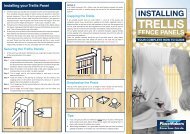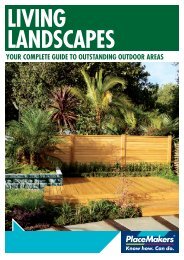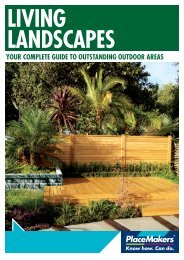PERGOLA - PlaceMakers
PERGOLA - PlaceMakers
PERGOLA - PlaceMakers
Create successful ePaper yourself
Turn your PDF publications into a flip-book with our unique Google optimized e-Paper software.
GETTING STARTED<br />
Pergolas are a useful and attractive addition ion to any<br />
section.<br />
• They provide support for climbing plants like roses,<br />
clematis, jasmine and honeysuckle.<br />
• Pergolas offer a focus and architectural form in a flat<br />
garden; or on a plain building.<br />
• Add a roof in clear corrugated material to provide<br />
shelter over a doorway or as a gazebo.<br />
This brochure has instructions for a free-standing pergola,<br />
and one fixed to a building or a wall.<br />
Materials<br />
Instructions<br />
1. Free Standing Option 1<br />
Free Standing Pergola<br />
• 100 x 100mm H5 posts – 4 @ 3 metres<br />
• 150 x 50mm H3.2 bearers – 4 @ 2.7 metres<br />
• 150 x 50mm H3.2 rafters – 9 @ 2.7 metres<br />
• 10mm H3 Packers<br />
• 8 x 210mm x 12mm diameter hot-dipped galvanised coach bolts, nuts and<br />
50 x 50mm square washers or 55mm diameter round washers.<br />
• Petroleum grease<br />
• 75mm hot-dipped galvanised jolthead nails<br />
• Cement<br />
• Builders mix<br />
2. Fixed to the House<br />
1. Setting out the holes:<br />
a) Take two lengths of 150 x 50mm timber, and mark two lines, 2.4 metres<br />
apart, across both.<br />
b) Take two more pieces and mark two lines 2.3 metres apart<br />
2.4 metres<br />
d) Leave the concrete to set for at least 24 hours.<br />
When the concrete is set, top up hole with soil, then measure 2.3 metres<br />
from ground level on one post.<br />
e) Level that mark around onto each of the others. Level using a string level<br />
and string line, or a spirit level on a plank. Check accuracy of all marks by<br />
levelling between fourth and fi rst post.<br />
f) Square and cut posts to height(s).<br />
NOTE: If you intend to cover your pergola with clear corrugate, allow a fall<br />
of 50mm in the direction you want it to drain. E.G. on Post 2 mark 50mm<br />
below level line. Level that lower mark across to Post 3. Then level the<br />
original height from Post 1 to 4.<br />
3. Fixing the Bearers<br />
a) Cut four bearers from 150 x 50mm at 2.7metres long. Check dimensions at<br />
post top before cutting. Shape ends of bearers if desired, remembering that<br />
no part of the shaping should extend more than 150mm from end of bearer<br />
( see Illustration 2 ), unless you wish to use bearers longer than 2.7metres.<br />
“The most renewable natural resource” for more information visit our<br />
website www.nzwood.co.nz<br />
The Law<br />
You should ask your council if you need a building<br />
consent and/or planning permission.<br />
Ideas & Inspiration<br />
• 100 x 100mm H5 posts – 2 @ 3 metres<br />
• 150 x 50mm H3.2 bearers – 3 @ 2.7 metres<br />
• 150 x 50mm H3.2 rafters – 9 @ 2.7 metres<br />
• 4 x 210mm x 12mm diameter hot-dipped galvanised coach bolts, nuts and<br />
washers<br />
• Petroleum grease<br />
• 4 x 125mm x 12mm diameter hot-dipped galvanised coach screws and<br />
washers; or 4 x 125mm x 12mm Dyna bolts.<br />
• 75mm hot-dipped galvanised jolthead nails<br />
• Cement<br />
• Builders mix<br />
2.3<br />
metres<br />
2<br />
Diagonals<br />
the same<br />
3<br />
Posts<br />
Note<br />
Where corrosion levels are high, as in the case of a coastal environment subject<br />
to sea spray, stainless steel should be used for bolts, nails and fittings.<br />
1<br />
4<br />
Tools<br />
Spade or post hole<br />
borer<br />
Circular saw<br />
Electric drill, 12mm<br />
auger bit & either 9mm<br />
twist bit or masonry bit<br />
(check requirements for<br />
Dyna bolts)<br />
Adjustable spanner<br />
(250mm)<br />
2 G or F clamps<br />
Spirit level or line level<br />
Tape measure, square<br />
and pencil<br />
Sandpaper<br />
Jigsaw if cutting<br />
curves on ends of<br />
rafters (optional)<br />
Illustration 1: Laying out post holes<br />
c) Lay planks together in a rectangle so the inside of each plank rests on the<br />
lines of planks beneath it. (The planks can be temporarily tacked at the<br />
corners).<br />
d) Position rectangle where you want your pergola.<br />
e) Square the corners by checking that diagonals are the same length<br />
( see Illustration 1 ).<br />
f) The inside of each corner of the rectangle, marks the outside corner of each<br />
post.<br />
g) Mark post positions on the ground, dismantle and remove rectangle. Dig four<br />
300mm diameter holes at least 900mm deep.<br />
2. Installing the Posts<br />
a) Place 100mm concrete in the bottom of each hole and set the posts in place<br />
on top. Make sure uncut treated ends go into the hole.<br />
b) Check for plumb levels (vertical) in both directions and brace securely.<br />
c) Pour concrete to 150mm below ground level. Check for plumb again and<br />
rebrace if necessary.<br />
Illustration 2: Bearer and joist end shape option<br />
b) Temporarily nail bearers to Posts 1 and 4 and Posts 2 and 3. Top edge of<br />
bearers should be fl ush with tops of posts. Sandwich post between bearers<br />
( see Illustration 3 ). Bearers should overhang posts by 150mm at each end.<br />
Ensure that temporary nails are in the middle of each bearer as bolt holes<br />
have to be bored above and below that.<br />
c) Mark points 40mm from the bottom and top edges of the bearers, in the<br />
centre of the posts. Bore two 12mm holes through the bearers and posts on<br />
those points. If your auger bit is less than 200mm long, measure and bore<br />
from both sides, ensuring that you maintain holes level and square to the<br />
face of the bearer, so the holes from each side meet up.<br />
d) Grease the bolts liberally, bolt through holes and tighten.<br />
Please Note:<br />
While the advice and recommendations contained in this brochure<br />
have been produced with proper care, they are offered only with<br />
the objective of assisting those interested in home improvement<br />
projects. <strong>PlaceMakers</strong> does not accept responsibility for the advice,<br />
recommendations, etc. contained herein.<br />
Updated: December 2008 (FM1002 12/08)<br />
www.placemakers.co.nz
















